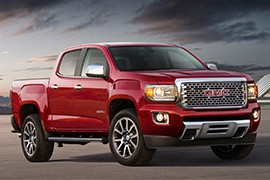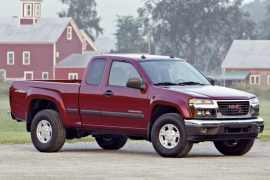GMC Canyon Crew Cab Models/Series Timeline, Specifications & Photos
First production year: 2004
Engines: Gasoline, Diesel
Body style: Truck
When the GM and Isuzu joined their forces to built reliable workhorses on four wheels, they also agreed who will sell where. And the GM had the U.S. This is how the GMC Canyon ended up having the same chassis as an Isuzu D-Max.
The GMC Canyon was the kind of truck that could be used as a daily driver and a weekend companion. It was developed as a premium midsize truck, with an impressive front fascia that evoked power and supremacy on the road. The Denali trim level even had a massive chrome grille and unique 20” wheels. The flared arches added some muscular lines to the vehicle.
The Crew Cab was the four-door version and a true 5-seater. Inside, the dashboard was closer to an SUV than to a utility truck. And the vehicle was good to serve well for both purposes. In the center console, a standard 8” touchscreen infotainment system was installed and was able to connect via Android Auto and Apple CarPlay. It featured OnStar 4G LTE connectivity and WiFi hot-spot.
Under the hood, the Canyon had two engine choices, depending on the market. The standard model featured a 3.6-liter V6 unit installed and a 2.8-liter Duramax turbo-diesel was offered as an option. Both were mated as standard with a 6-speed automatic. It was offered in a 2WD or 4WD configuration and it was able to tow up to 7,000 lbs (3,175 kg).
GM doubled its offer on the light pickup market with the Canyon, GMC's version of the Chevrolet Colorado.
General Motors and Isuzu were already partners for a long time, and they decided to develop a new utility vehicle. For specific markets, Isuzu used its bodywork and sold the car as D-Max while the American carmaker sold it on the U.S. market under the bow-tie brand and GMC. The Crew Cab was one of GMC's cabins and featured a pair of suicide-doors in the back, plus a set of jump-seats in addition to the front ones.
GMC imagined an aggressive design for the Canyon, featuring two rows of lamps at the front. The same idea was carried over on the larger pickup-trucks from the GMC. Depending on the trim level, the vehicle featured body-colored or chromed bumpers. To pass the IIHS testings, GMC had to build the car, so the rear-hinged rear doors could have been opened only if the front ones were not closed. Its flared arches on the sides made the car look more aggressive, even though it was just a pickup truck in the same market segment as the Dodge Dakota or the Ford Ranger.
Inside, the carmaker installed a bench-seat on the base trim level or bucket seats. On the versions fitted with a manual gearbox, the gear-stick was installed on the center console. For the automatic version, the carmaker moved the lever on the steering column. The rear seats offered limited room for two passengers, mostly for short distances.
Under the hood, GMC offered a choice of five engines with up to eight cylinders. The base models featured a rear-wheel-drive or a 4x4 with a low-range transfer box.

